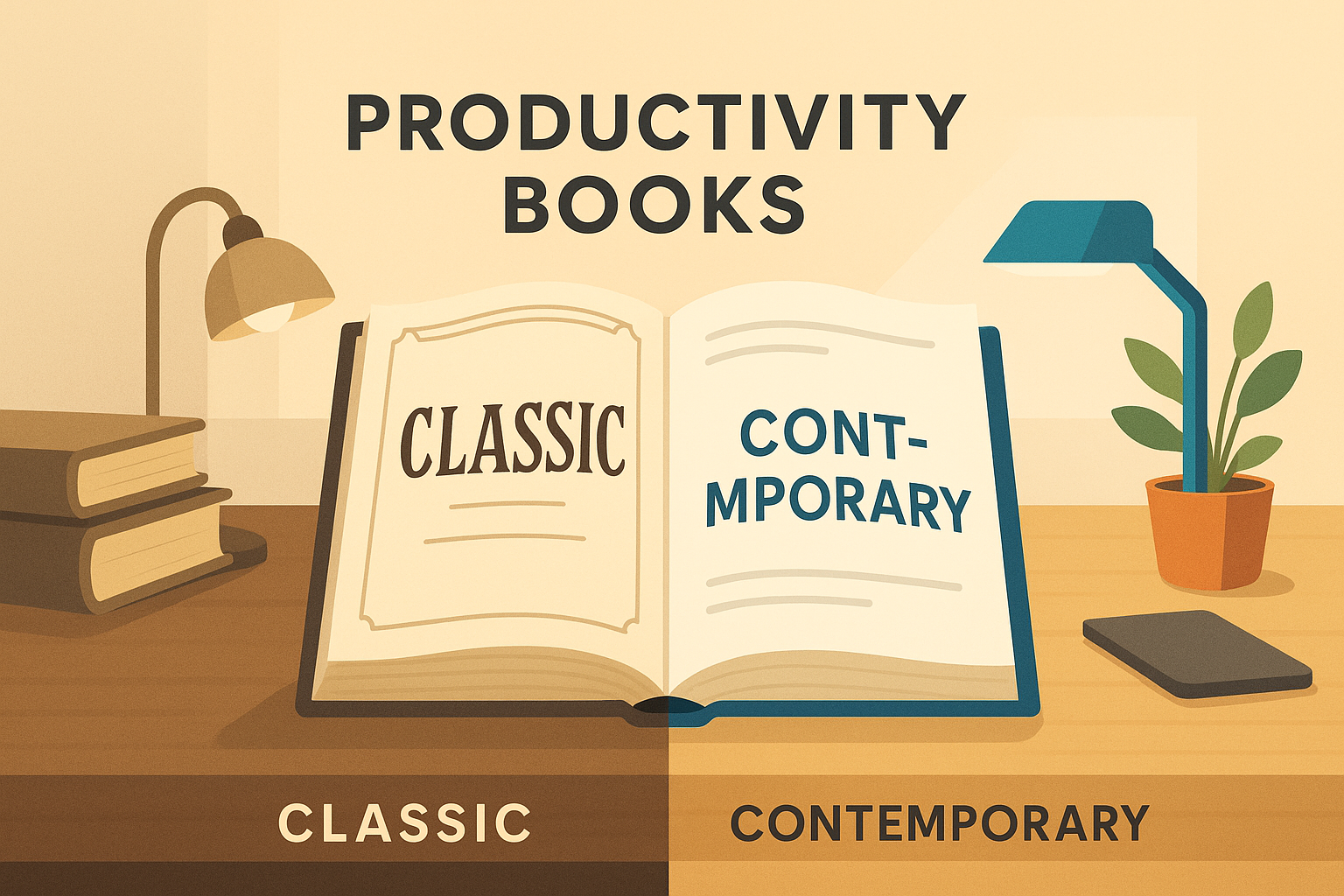Want to connect business theory with real-world challenges? These 10 books combine actionable strategies with case studies from various industries to help students sharpen their critical thinking and apply concepts effectively. Here's what you'll get:
- Good to Great: Learn how companies achieve lasting success through disciplined leadership and strategic focus.
- Blue Ocean Strategy: Discover how to create untapped markets and make the competition irrelevant with tools like the Strategy Canvas.
- The Lean Startup: Master rapid testing and iteration to build successful businesses in fast-moving markets.
- Thinking, Fast and Slow: Understand how two types of thinking - intuitive and analytical - impact decision-making in business.
- The Innovator's Dilemma: Explore why great companies fail to adapt to disruptive technologies and how to avoid it.
- Start with Why: Inspire action by focusing on your core purpose using the Golden Circle framework.
- Made to Stick: Learn how to make ideas memorable with the SUCCESs model for communication.
- Measure What Matters: Use OKRs (Objectives and Key Results) to set and achieve ambitious goals.
- The Hard Thing About Hard Things: Navigate tough business challenges with lessons on leadership, crisis management, and adaptation.
- Scaling Up: Build sustainable growth by focusing on people, strategy, execution, and cash management.
Quick Comparison
| Book Title | Focus | Key Case Studies/Examples |
|---|---|---|
| Good to Great | Leadership and organizational success | Kroger, Circuit City |
| Blue Ocean Strategy | Market innovation | Cirque du Soleil, Yellow Tail Wines |
| The Lean Startup | Entrepreneurship and innovation | IMVU, Dropbox |
| Thinking, Fast and Slow | Decision-making processes | Israeli Air Force, medical diagnosis |
| The Innovator's Dilemma | Adapting to disruptive technologies | Disk drives, steel mini-mills |
| Start with Why | Leadership and marketing | Apple, Southwest Airlines |
| Made to Stick | Memorable communication | Subway's Jared campaign, Disney |
| Measure What Matters | Goal setting with OKRs | Google, Gates Foundation |
| The Hard Thing About Hard Things | Leadership under pressure | Loudcloud, Netscape |
| Scaling Up | Business growth strategies | Rackspace, Gazelles Growth Institute |
These books are perfect for students aiming to excel in business strategy, leadership, and innovation. Start with one that matches your career goals or current projects!
I read 1800 business books - these 10 will make you RICH
1. Good to Great: Why Some Companies Make the Leap... and Others Don't by Jim Collins
First published in 2001, Good to Great explores how some companies manage to rise above mediocrity and achieve lasting success. Jim Collins and his research team analyzed numerous case studies to uncover the key drivers behind consistent high performance.
Collins argues that moving from "good" to "great" requires disciplined leadership, a clear strategic focus, and consistent execution - not just a single moment of success or reliance on a charismatic leader. Using real-world examples, the book highlights how companies that face challenges head-on and stick to their core principles are more likely to thrive over the long term. These case studies provide actionable insights that are particularly useful for students and professionals alike.
Up next, we’ll dive into another impactful book that offers strategic insights through case studies.
2. Blue Ocean Strategy: How to Create Uncontested Market Space and Make the Competition Irrelevant by W. Chan Kim and Renée Mauborgne
Blue Ocean Strategy introduces the concepts of 'blue oceans' - new, untapped markets - and 'red oceans,' which represent overcrowded, competitive industries, using real-world examples to bring these ideas to life.
One standout case study is Cirque du Soleil. By merging traditional circus elements with theatrical performances, they created an entirely new market, redefining what a circus could be.
The book outlines the Four Actions Framework, a practical tool for crafting strategies in blue ocean markets:
- Eliminate: Identify and remove elements the industry has always relied on but no longer needs.
- Reduce: Scale back areas that are overemphasized compared to customer needs.
- Raise: Focus on improving aspects that matter most to customers.
- Create: Introduce new features or services that the market has never seen before.
To help visualize and compare market positions, the Strategy Canvas is introduced. This tool highlights how a company’s offerings differ from competitors, making it easier to identify opportunities for standing out.
This book equips readers with actionable methods to develop strategies that break away from crowded markets and focus on fresh opportunities. Stay tuned as we explore another business classic that connects theory with practical challenges.
3. The Lean Startup: How Today's Entrepreneurs Use Continuous Innovation to Create Radically Successful Businesses by Eric Ries
Eric Ries's The Lean Startup introduces a scientific method to business development, focusing on rapid testing, iteration, and learning from real-world feedback. This approach helps students test ideas quickly and refine them, making it easier to adapt to the fast-moving business world.
Here are two core ideas from the Lean Startup method:
- Build-Measure-Learn Cycle: Start with a minimum viable product (MVP), collect customer feedback, and refine the product based on what you learn.
- Validated Learning: Instead of relying on traditional market research, test your assumptions through experiments to see what works.
4. Thinking, Fast and Slow by Daniel Kahneman
Daniel Kahneman, a Nobel laureate, explores how two types of thinking shape our decisions and behavior. Through examples and experiments, the book explains these mental processes and their influence on judgment - making it a must-read for business students.
The book introduces two key modes of thought:
- System 1 Thinking: This is fast, automatic, and requires little effort. It handles intuitive decisions and emotional reactions.
- System 2 Thinking: This is slower and deliberate, involving conscious thought and logical reasoning. It's used for analytical problem-solving and detailed evaluation.
For business students, understanding these systems is essential. These mental processes directly impact how strategies are developed and decisions are made in various business contexts.
System 1 can lead to quick, instinctive decisions, but overreliance on it may result in poor judgment. On the other hand, System 2 allows for deeper analysis and careful risk assessment. Striking the right balance between these modes is key to crafting effective strategies.
Here’s how these insights apply across different business areas:
| Business Area | System 1 Influence | System 2 Role |
|---|---|---|
| Marketing | Drives immediate consumer reactions | Guides data-driven campaign analysis |
| Strategy | Relies on gut instinct | Supports thorough planning and evaluation |
| Leadership | Encourages fast decision-making | Enables long-term organizational planning |
| Operations | Manages habitual processes | Focuses on analytical improvements |
Kahneman's work provides practical tools to navigate both instinctive and analytical thinking, helping business professionals make better decisions in real-world scenarios.
5. The Innovator's Dilemma: When New Technologies Cause Great Firms to Fail by Clayton M. Christensen
Clayton Christensen’s book dives into a key challenge in business: why companies that seem to be doing everything right still end up failing. It explores how even successful businesses can struggle when they overlook new trends.
The book outlines two main types of technological changes:
| Technology Type | Characteristics | Impact on Established Companies |
|---|---|---|
| Sustaining Technologies | Improve existing product performance | Companies usually succeed |
| Disruptive Technologies | Start off weaker but offer new benefits | Companies often fail to adjust |
This framework helps explain why established firms often stumble when disruptive innovations emerge.
Example: The Disk Drive Industry (1976-1992)
One of the book’s notable case studies examines the disk drive industry. Established manufacturers repeatedly failed to adapt to smaller, more efficient disk drive formats. New entrants, offering compact and innovative designs, eventually replaced them.
Why Successful Companies Struggle with Disruptive Innovation
Christensen identifies several reasons why established firms find it hard to handle disruptive technologies:
- Resource Allocation: Companies prioritize projects with the highest immediate returns, often favoring sustaining technologies.
- Market Focus: Established markets seem more appealing, leading firms to ignore emerging opportunities.
- Organizational Structure: Existing processes and company values can block unconventional ideas.
Practical Strategies for Tackling Disruption
The book also provides actionable advice for dealing with disruptive changes:
- Disruptive innovations often start in low-end or entirely new markets.
- Set up independent teams or units to focus on disruptive projects.
- Foster a culture that treats failure as a learning opportunity.
- Align your company’s size and strategy with the scale of the emerging market.
These lessons are especially relevant as industries continue to face fast-paced technological advancements.
6. Start with Why: How Great Leaders Inspire Everyone to Take Action by Simon Sinek
Simon Sinek explores how leaders can inspire action by focusing on their core purpose. In his book, he introduces the "Golden Circle" concept, which breaks down into three layers: Why, How, and What.
The Golden Circle Framework
| Layer | Description | Business Application |
|---|---|---|
| Why | Core purpose and beliefs | Mission and values guiding decisions |
| How | Unique processes and methods | Strategies and approaches for execution |
| What | Tangible products or services | The actual offerings provided to customers |
Here's how to apply this framework:
- Define your core purpose (Why): Identify what drives your organization at its core.
- Determine your methods and processes (How): Establish the strategies and approaches you’ll use to fulfill your purpose.
- Create your offerings (What): Develop the products or services that bring your purpose to life.
- Align decisions with your purpose: Ensure every action reflects your mission.
- Communicate through the Why-How-What lens: Keep your messaging consistent with this structure.
"Start with Why is considered a must-read for understanding how great leaders inspire action".
This method is especially effective in areas like:
- Strategic planning
- Marketing and branding
- Leadership training
- Organizational behavior
- Business model creation
sbb-itb-1ae7b2a
7. Made to Stick: Why Some Ideas Survive and Others Die by Chip Heath and Dan Heath
Chip and Dan Heath introduce the SUCCESs model, a framework designed to help ideas resonate and endure.
The SUCCESs Framework Components
| Component | Description | Examples of Use |
|---|---|---|
| Simple | Focus on the core message | Mission statements, value propositions |
| Unexpected | Break patterns to grab attention | Marketing campaigns, product launches |
| Concrete | Use clear, tangible examples | Project goals, customer experiences |
| Credible | Build trust through authority | Sales pitches, business proposals |
| Emotional | Connect with feelings | Brand storytelling, customer engagement |
| Stories | Use narratives to drive action | Case studies, team culture |
Together, these principles create a structured approach to making communication more engaging and memorable, applicable across various fields like marketing, leadership, and strategy.
How Students Can Use These Principles
Students can apply the SUCCESs model in several ways:
- Business Strategy: Develop concise mission statements and articulate company values.
- Marketing: Create advertising campaigns that stand out and craft compelling brand messages.
- Leadership: Present a clear vision and communicate strategies effectively.
- Product Development: Design strong, focused value propositions.
- Sales: Build persuasive presentations for clients.
These principles have been successfully utilized by organizations in different industries, proving their usefulness in crafting better communication and strategies.
8. Measure What Matters: How Google, Bono, and the Gates Foundation Rock the World with OKRs by John Doerr

This book highlights how OKRs (Objectives and Key Results) have transformed organizations like Google, the Gates Foundation, and others. Introduced at Google in 1999 during its early days, this framework has become a cornerstone for achieving ambitious goals.
Key Components of the OKR Framework
| Component | Description | Example |
|---|---|---|
| Objectives | Ambitious, qualitative goals | "Become the market leader in cloud computing" |
| Key Results | Quantifiable metrics to track progress | "Achieve 99.99% service uptime" |
| Time Frame | Defined periods for tracking progress | Quarterly or annually (e.g., Q1–Q4) |
| Scoring | A scale to measure success | 0.0–1.0 scale (e.g., 0.7–1.0 indicates success) |
Practical Applications
The Gates Foundation showcases how OKRs can drive measurable outcomes in social initiatives. By setting clear objectives, tracking progress with data, and refining strategies, the Foundation ensures resources are effectively used to create meaningful change. This approach serves as a blueprint for applying OKRs across various fields.
Applying OKRs as a Student
Students can use OKRs to:
- Set academic and personal goals
- Manage research projects effectively
- Lead teams and track internship progress
- Plan and measure career development
To make OKRs work, focus on:
- Setting ambitious, but achievable goals
- Using clear, measurable metrics
- Maintaining transparency within teams
- Sticking to deadlines
- Aligning individual objectives with broader goals
OKRs offer a clear framework to connect strategic plans with measurable results, making them an essential tool for navigating today’s goal-oriented world.
9. The Hard Thing About Hard Things: Building a Business When There Are No Easy Answers by Ben Horowitz
Ben Horowitz shares his firsthand experiences from leading companies like Loudcloud and Opsware, shedding light on the challenges that arise when typical business strategies fall short. As the co-founder of Andreessen Horowitz and an experienced tech executive, Horowitz dives into the complexities of navigating unpredictable business situations. He brings these lessons to life through real-world examples.
Real-World Case Studies
Horowitz uses case studies to highlight issues such as market downturns, cash flow problems, and the need for strategic pivots. His honest storytelling underscores the importance of making tough decisions and maintaining open communication when conventional methods don't work.
Key Leadership Takeaways
-
Leading Through Crises
Handling economic or operational crises requires hard choices, clear communication, and efforts to keep morale intact. -
Adapting Leadership Styles
Leadership during crises (wartime) calls for quick, decisive actions, while calmer periods (peacetime) focus on steady growth and stability. -
Developing Strong Teams
Strengthen your team by mentoring managers directly and providing clear frameworks for decision-making.
Practical Lessons for Students
For future business leaders, The Hard Thing About Hard Things offers a realistic look at what it takes to run a company in unpredictable conditions. The book’s focus on crisis management, leadership under pressure, and adapting to change provides a solid foundation for tackling challenges in fast-moving business environments. It’s an essential guide for anyone preparing to lead in high-stakes situations.
10. Scaling Up: How a Few Companies Make It...and Why the Rest Don't by Verne Harnish
In Scaling Up, Verne Harnish presents a practical framework for business growth, built around four main areas: People, Strategy, Execution, and Cash. Through case studies and actionable advice, the book highlights how businesses can navigate challenges and achieve sustainable growth. It expands on earlier concepts to provide a deeper understanding of scaling operations.
The book includes real-world examples, showcasing both successes and missteps. These stories offer valuable insights into the complexities of scaling a business.
Key Growth Strategies
- People: Focus on assembling a team that shares the company’s vision and goals.
- Strategic Planning: Create clear, measurable objectives to align efforts across the organization.
- Execution: Maintain operational efficiency through structured processes and regular reviews.
- Cash Management: Ensure healthy cash flow to support long-term growth.
Lessons for Students
The strategies and case studies in Scaling Up serve as a guide for applying business concepts in real-world settings. They illustrate how smart planning and disciplined execution can lead to success. For students, this knowledge is especially useful when preparing to start or expand their own ventures.
Check out the next section for a Book Comparison Guide that places these strategies in a broader context.
Book Comparison Guide
This guide highlights key features of various books to help you make an informed choice for targeted study.
| Book Title | Primary Focus | Industry Examples | Reading Level | Key Case Studies |
|---|---|---|---|---|
| Good to Great | Leadership and Organizational Development | Technology, Retail, Manufacturing | Intermediate | Kroger's rise to market leader, Circuit City's trajectory |
| Blue Ocean Strategy | Market Innovation | Entertainment, Technology, Services | Advanced | Cirque du Soleil's circus reinvention, Yellow Tail wines |
| The Lean Startup | Entrepreneurship and Innovation | Software, Technology, Services | Intermediate | IMVU's pivot, Dropbox's MVP development |
| Thinking, Fast and Slow | Decision Making | Cross-industry | Advanced | Israeli Air Force training, medical diagnosis methods |
| The Innovator's Dilemma | Disruptive Innovation | Technology, Manufacturing | Advanced | Disk drive evolution, steel mini-mills' market entry |
| Start with Why | Leadership and Marketing | Technology, Retail, Aviation | Beginner | Apple's marketing, Southwest Airlines' culture |
| Made to Stick | Communication and Marketing | Education, Healthcare, Business | Intermediate | Subway's Jared campaign, Disney's service stories |
| Measure What Matters | Goal Setting and Management | Technology, Philanthropy | Intermediate | Google's OKR system, Intel's operational strategies |
| The Hard Thing About Hard Things | Leadership and Management | Technology, Startups | Advanced | Loudcloud's transformation, Netscape's browser wars |
| Scaling Up | Business Growth | Manufacturing, Services, Technology | Intermediate | Rackspace's expansion, Gazelles Growth Institute cases |
Application Guide by Study Focus
- Marketing: Dive into Blue Ocean Strategy, Start with Why, or Made to Stick for frameworks on market shifts and effective communication.
- Management: Explore Good to Great, Measure What Matters, or Scaling Up for leadership and organizational strategies.
- Entrepreneurship: Start with The Lean Startup and The Hard Thing About Hard Things for actionable advice on building and scaling startups.
Time Investment Guide
Plan to spend 8–12 hours per book for thorough reading.
Learning Tips:
- Quick Study: Focus on chapters with relevant case studies that match your interests.
- Deep Analysis: Read the entire book for a full understanding of strategies.
- Practical Use: Apply one framework from each book to your current projects.
Books like Start with Why are easier to grasp for beginners, while advanced texts like The Innovator's Dilemma demand more time and focus. Pick a book that fits your experience level and goals.
Key Learning Points
This section highlights practical takeaways from the case studies above, offering frameworks you can use right away.
Strategic Decision-Making
Books like Good to Great and Blue Ocean Strategy provide tools to analyze market opportunities and assess competitive positioning - perfect for case competitions and coursework.
Innovation and Entrepreneurship
Use strategies from The Lean Startup and The Innovator's Dilemma to test ideas and grow ventures effectively.
Leadership Development
Draw on lessons from Start with Why and The Hard Thing About Hard Things to guide student groups, manage organizations, and perform well in internships.
Practical Applications for Students
| Academic Setting | Professional Setting | Book Applications |
|---|---|---|
| Case Studies | Internships | Use Blue Ocean Strategy for market analysis |
| Group Projects | Leadership Roles | Apply Start with Why to inspire teams |
| Business Plans | Startups | Follow Lean Startup for idea validation |
| Research Papers | Corporate Jobs | Reference Good to Great for organizational insights |
Implementation Strategy
Start by focusing on one framework that aligns with your current academic or career goals. Incorporating marketing concepts can also help you better understand consumer behavior and improve your competitive edge.
Skill Development Focus
Books on corporate strategy strengthen your ability to plan for growth, analyze competition, and make informed decisions - skills that are crucial for case studies and business simulations.
FAQs
How can students use insights from these business books in internships or real-world projects?
Students can apply the concepts from these business books by identifying key lessons that align with their specific projects or internship goals. For example, if a book emphasizes team collaboration, they can implement strategies to improve communication or streamline group efforts in their workplace. Similarly, insights on problem-solving or decision-making can help tackle challenges effectively.
To maximize impact, students should take notes while reading, reflect on how the ideas relate to their field, and actively experiment with these strategies in their roles. Combining theory with hands-on application is the best way to bridge the gap between learning and practice.
How can students apply lessons from 'The Lean Startup' and 'The Innovator's Dilemma' to launch a successful business?
Both The Lean Startup by Eric Ries and The Innovator's Dilemma by Clayton Christensen offer valuable strategies for building and scaling a business. Here are some practical ways to apply their lessons:
- Embrace experimentation and adaptability: Use the Build-Measure-Learn feedback loop from The Lean Startup to test ideas quickly, gather customer feedback, and refine your product or service based on real-world insights.
- Focus on disruptive innovation: From The Innovator's Dilemma, understand how smaller, innovative solutions can challenge established markets. Identify underserved customer needs and develop solutions that prioritize affordability and accessibility.
- Start small and scale thoughtfully: Both books emphasize starting with a minimum viable product (MVP) to reduce risk and ensure your business concept resonates with your target audience before scaling.
By combining these approaches, you can create a flexible, customer-focused strategy that positions your business for long-term success.
What is the best book on the list for developing leadership skills in a corporate environment?
The list highlights several excellent business books with case studies, each offering valuable insights. For improving leadership skills specifically, look for titles that focus on corporate leadership, team management, and decision-making. These books often include real-world scenarios and strategies that can help you navigate challenges in a professional setting. Review the descriptions of each book in the article to find the one best suited to your goals.


